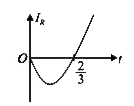A long solenoid of radius R carries a time (t)-dependent current I(t)=I0t2(1−t). A conducting ring of radius 3R is placed co-axially near its middle. During the time interva 0≤t≤1, the induced current (IR) in the ring varies as: [Take resistance of ring to be R0]




The correct Answer is:B
To solve the problem, we need to find the induced current IR in a conducting ring of radius 3R placed coaxially with a long solenoid carrying a time-dependent current I(t)=I0t2(1−t). We will follow these steps:
Step 1: Determine the Magnetic Field Inside the Solenoid
The magnetic field B inside a long solenoid is given by the formula:
B=μ0nI
where n is the number of turns per unit length and I is the current flowing through the solenoid. Since the current is time-dependent, we substitute I(t):
B(t)=μ0nI0t2(1−t)
Step 2: Calculate the Magnetic Flux Through the Ring
The area A of the conducting ring is given by:
A=π(3R)2=9πR2
The magnetic flux Φ through the ring is given by:
Φ(t)=B(t)⋅A=μ0nI0t2(1−t)⋅9πR2
Thus, the magnetic flux becomes:
Φ(t)=9πμ0nI0R2t2(1−t)
Step 3: Calculate the Induced EMF
According to Faraday's law of electromagnetic induction, the induced EMF E is given by the negative rate of change of magnetic flux:
E=−dΦdt
Calculating the derivative:
dΦdt=9πμ0nI0R2ddt(t2(1−t))
Using the product rule:
ddt(t2(1−t))=2t(1−t)−t2=2t−3t2
Thus, we have:
E=−9πμ0nI0R2(2t−3t2)
Step 4: Calculate the Induced Current
Using Ohm's law, the induced current IR in the ring can be calculated as:
IR=ER0=−9πμ0nI0R2(2t−3t2)R0
This simplifies to:
IR=−9πμ0nI0R2R0(2t−3t2)
Step 5: Analyze the Current Function
The expression for the induced current IR is:
IR=−k(2t−3t2)
where k=9πμ0nI0R2R0. The current will be zero when:
2t−3t2=0⟹t(2−3t)=0
This gives t=0 and t=23.
Conclusion
The induced current IR varies as a quadratic function of time, reaching zero at t=0 and t=23.
The magnetic field B inside a long solenoid is given by the formula:
B=μ0nI
where n is the number of turns per unit length and I is the current flowing through the solenoid. Since the current is time-dependent, we substitute I(t):
B(t)=μ0nI0t2(1−t)
The area A of the conducting ring is given by:
A=π(3R)2=9πR2
The magnetic flux Φ through the ring is given by:
Φ(t)=B(t)⋅A=μ0nI0t2(1−t)⋅9πR2
Thus, the magnetic flux becomes:
Φ(t)=9πμ0nI0R2t2(1−t)
According to Faraday's law of electromagnetic induction, the induced EMF E is given by the negative rate of change of magnetic flux:
E=−dΦdt
Calculating the derivative:
dΦdt=9πμ0nI0R2ddt(t2(1−t))
Using the product rule:
ddt(t2(1−t))=2t(1−t)−t2=2t−3t2
Thus, we have:
E=−9πμ0nI0R2(2t−3t2)
Using Ohm's law, the induced current IR in the ring can be calculated as:
IR=ER0=−9πμ0nI0R2(2t−3t2)R0
This simplifies to:
IR=−9πμ0nI0R2R0(2t−3t2)
The expression for the induced current IR is:
IR=−k(2t−3t2)
where k=9πμ0nI0R2R0. The current will be zero when:
2t−3t2=0⟹t(2−3t)=0
This gives t=0 and t=23.
The induced current IR varies as a quadratic function of time, reaching zero at t=0 and t=23.
Similar Questions
Switch is closed at t=0 then the current in the circuit at t=L2R is
_PHY_E06_157_Q01.png)
View SolutionA long solenoid of radius R carries a time (t) – dependent current I=I0(t−2t2) A circular ring of radius = R is placed near the centre of the solenoid and plane of ring makes an angle 30∘ with the axis of solenoid. The time at which magnetic flux through the ring is maximum is :
View Solution
Knowledge Check
A long solenoid of radius R carries a time dependent current I=I0t(1–t). A ring of radius 2R is placed coaxially near its centre. During the time interval0≤t≤1, the induced current IR and the induced emf VR in the ring vary as:
Acurrent will change its direction and its emf will be zero at t = 0.25sec.Bcurrent will not change its direction & emf will be maximum at t = 0.5secCcurrent will not change direction and emf will be zero at 0.25sec.Dcurrent will change its direction and its emf will be zero at t = 0.5sec.long solenoid of radius R carries a time –dependent current I(t)=I0(12t−t3) . A ring of radius 2R is placed coaxially near its middle. During the time interval 0≤t≤2√3 , the induced current (IR) and the induced EMF (VR) in the ring change as :
AAt t = 1 direction of IR reverses and VR is maximumBAt t = 2 direction of IR reverses and is VR zeroCDirection of IR remain unchanged and VR is zeroDDirection of IR remains unchanged and VR is maximumA long solenoid of radius R carries a time (t) – dependent current I=I0(t−2t2) A circular ring of radius = R is placed near the centre of the solenoid and plane of ring makes an angle 30∘ with the axis of solenoid. The time at which magnetic flux through the ring is maximum is :
A0.5 secB1.0 secC0.25 secD0.75 sec
A conducting ring of radius b is placed coaxially in a long solenoid of radius a (b < a) having n turns per unit length. A current i=i0, cosωt flows through the solenoid. The induced emf in the ring is
View SolutionIf i=t2,0<t<T then r.m.s. value of current is
View SolutionA solenoid of radius R and length L has a current I=I0 cosωt. The value of induced electric field at a distance of r outside the solenoid, is
View SolutionA solenoid of radius R number of turn per unit length n and length L has a current I=I0cosωt. The value of induced electric field at a distance of r outside the solenoid, is :
View SolutionA current (I) carrying circular wire of radius R is placed in a magnetic field B perpendicular to its plane. The tension T along the circumference of the wire is

View Solution